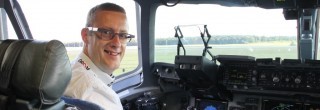 The United States is a great destination for history lovers. Perhaps surprising, as its modern history is not that long compared to other places in the world. Americans are masters of preservation and maintain their heritage better than in any other country. Much of modern history happened in the US, so if your interest is in the 18th, 19th or 20th centuries, there are many very well-kept must-sees. One of my areas of interest is the history of aviation. In this blog I will describe some of my expeditions to find special aviation places and objects. The first expedition is to Kitty Hawk, North Carolina.
The United States is a great destination for history lovers. Perhaps surprising, as its modern history is not that long compared to other places in the world. Americans are masters of preservation and maintain their heritage better than in any other country. Much of modern history happened in the US, so if your interest is in the 18th, 19th or 20th centuries, there are many very well-kept must-sees. One of my areas of interest is the history of aviation. In this blog I will describe some of my expeditions to find special aviation places and objects. The first expedition is to Kitty Hawk, North Carolina.

Where is Kitty Hawk North Carolina?
Funny enough there are no major airports close to Kitty Hawk. I fly into Norforlk VA where I rent a car to drive the last 140 km to Kitty Hawk. Renting a car is a good idea, as it allows to see other interesting sites in the area, like nearby Roanoke Island and the Fort Raleigh National Historic Site, a 1584 British pioneer settlement of the times well before Jamestown and Plymouth were founded.

Welcome to the town of Kitty Hawk, birthplace of flight. Kitty Hawk NC is located on the so-called Outer Banks, a long peninsula on the Atlantic Ocean, parallel to the East Coast. The highway 12 coast road connects all towns in this special and remote part of the US.

The rain is pooring down when I enter the Wright Brothers National Memorial, managed by the US National Park Service. The memorial is located just outside the town of Kill Devil Hills, named after the hilly dunes that form part of the landscape here. This remote place is holy ground for any aviation enthusiast.

Obviously there is a copy of the Wright Flyer inside the small visitor center. The rest of the museum is dedicated to the history of Orville and Wilbur Wright. The main exhibit offers a great view of the famous grounds where the brothers spent a few years until their successful flights on 17 December 1903.

The Wright Flyer on a sign against the background where it was developed and perfected. First glider tests took place from the hill in the background, behind the simple hanger and living quarters of the brothers.

It is pooring down, but these grounds have to be walked on. These two simple shacks are exact replicas of the buildings that the brothers used between 1900 and 1903.

From this simple rail the first motorized flight of an aircraft heavier than air started. The Wright Flyer lifted off from the rail at the location of the memorial stone. It ended about 40 meters further away.

The famous first flight ended here, after 12 seconds. The simple plane flew about 1 meter above the field.

In an attempt to replicate his brother’s success, Wibur took the controls for a second flight, which landed just a few meters from the first landing point. Their third attempt got them a little further again, at the next marker in this picture. Already at their fourth flight they got the machine under control, allowing Wilbur to stay airborn for a minute, flying all the way to the end of this field, 852 feet away. The landing was less successful, breaking the support structure, which meant the end of tests on that historic day.

The famous picture of the first flight is replicated at full scale in 3D, not far from the monument on the hill. This is the moment that the plane with Orville behind the controls take off from the guide rail for its first 40 meter flight.

The cheering witnesses of the historic moment frozen in bronze forever. A truly emotional image.

The photographer of the first picture of the first flight, taking his famous shot.

Funny how we can travel all over the world and sometimes miss the stuff closer to home. We have never been to Kitty Hawk, but it sure looks like we need to make a stop sometime. Thanks.
I’ve read so much about the Wright Brothers and their extended family. Being from North Carolina; I am, of course, proud that the first flight took place in our state, such as it was.
I realize of course, that the first, true airplane was developed in Dayton, Ohio. I’m just glad that we had plenty of sand, dunes and wind so they didn’t break their necks before finishing their feat.